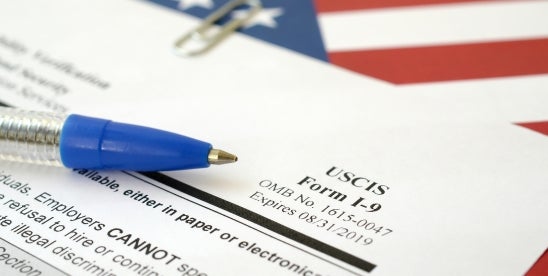
Ensuring compliance with Form I-9 requirements has never been more critical. With shifting immigration policies, heightened enforcement priorities, and the introduction of new executive orders, employers face increasing challenges in verifying employment eligibility accurately and lawfully. Mistakes in completing or maintaining I-9 forms can result in hefty fines, legal penalties, and reputational damage.
Employers should take swift action now to conduct I-9 audits given the Trump Administration’s immediate actions to change or influence U.S. immigration policies, to remove undocumented aliens from the U.

S., and recent efforts to change programs governing who has authorization to remain or work in the U.S.
Several of the Day One Executive Orders remind employers and immigrants that faithful execution of immigration laws of the U.S. is of utmost importance to the administration.
Also, the far-reaching Protecting The American People Against Invasion Executive Order revokes Biden-era immigration enforcement priorities, announces the obligation that anyone without immigration status registers with the U.S. government, and seeks to limit the use of parole and temporary protected status, among other immigration initiatives.
From an employer’s perspective, an individual lacking U.S. work authorization may include an individual who: Another Day One Executive Order Securing Our Borders – The White House indicates in Section 2 that the Trump administration will remove promptly all aliens who enter or remain in violation of Federal law, and Section 2(e) indicates the administration will pursue criminal charges against illegal aliens who violate the immigration laws; and against those who facilitate their unlawful presence.
The executive order also instructs the Secretary of Homeland Security to take all appropriate action to terminate categorical parole programs including the parole program for Cubans, Haitians, Nicaraguans, and Venezuelans. Based on a notice published in the Federal Register on March 25, 2025, the above-referenced temporary parolees whose parole has not already expired by April 24, 2025, will have status (and therefore work authorization) terminated as of that date. Similarly, those who have previously been granted Temporary Protected Status through the 2023 TPS designation for Venezuela are now in limbo following publication on February 5, 2025, of a Federal Register Notice ending the 2023 TPS designation for Venezuela.
Although this action is being challenged in federal court, the employment authorization documents issued under that designation are set to expire on April 2, 2025. With programs ending, enforcement priorities changing, and lawsuits determining the future of certain work authorization, it’s increasingly difficult for the most well-meaning employer to know whether their I-9s have been completed correctly. Employers likely are familiar with the I-9 requirements, but based on the increased emphasis on enforcement, it’s worth reminding employers that by signing the I-9, employers are attesting under penalty of perjury the following: Current instructions for the I-9 may be accessed here: Instructions for Form I-9, Employment Eligibility Verification.
As a reminder, it is unlawful for an employer to hire, recruit, or refer for a fee a foreign national knowing they are unauthorized to work in the U.S., and it is unlawful for a person or company to continue to employ a foreign national in the U.
S. knowing they are(or have become) unauthorized to work in the U.S.
Audits of I-9 Forms are one way for employers to see how well their teams are tracking expiration dates and maintaining records. Note that penalties for I-9 violations have been adjusted for inflation. Here is a representative selection of penalties: Immediately Minimize Risk Through Preventative Measures.
Employers may minimize risk and fines or penalties by regularly conducting I-9 audits. Please see specific recommendations below. Conduct Regular Self-Audits .
Establish a cadence for scheduled self-audits either by the company or outside counsel. Doing so ensures that employers are aware of any risk lurking within their I-9s in case the government were to issue a Notice of Inspection A self-audit increases an employer’s odds of identifying and mitigating mistakes before they become an issue. Remember, it is unlawful to continue to employ a foreign worker in the United States knowing they are (or have become) an unauthorized alien with respect to employment.
Monitor Updates. Prior to each self-audit, familiarize yourself with any updates to the Handbook for Employers M-274. For example, on March 26, 2025, USCIS announced that Section 7.
4.2 of the M-274 Handbook was updated to reflect a DHS final rule automatically extending the duration of status and any employment authorization granted under 8 CFR C.F.
R. 274a.12(c)(3)(i)(B) or (C) for an F-1 student who is the beneficiary of an H-1B petition requesting a change of status.
Does the person who conducts your I-9 inspections, know of this change? How do the appropriate resources on your team find out about changes to ensure compliance? Does your team have the tools needed to perform their job? Do they have access to outside counsel? Attend Training . USCIS offers Employment Eligibility Webinars. Take advantage of same.
See Employment Eligibility Webinars | USCIS . If you have outside Counsel, have them conduct a training for your team whenever you have a change in your team who handles I-9s. Roster of Employees.
Ensure you have a complete and updated roster of employees, including former employees who left less than 1 year ago. Retention Schedule. Ensure you are not maintaining I-9s for any longer than needed- once an employee leaves, calculate when you may stop retaining the I-9.
It must be maintained for three years after the date of hire, or one year after the date employment ends, whichever is later. Remain Diligent. Ensure signatures aren’t missed and sections aren’t blank.
Do not back date documents. Know who to go to if you have questions..















